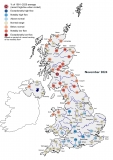Submitted by Nikos Mastrantonas on
July bore all of the hallmarks of a typical British summer: sunny and occasionally very hot weather accompanied by disruptive thunderstorm activity. Most memorably, a short exceptionally hot spell in late July, driven by a strong plume of continental air, culminated on the 25th in a new record UK temperature (for any month) of 38.7°C at Cambridge Botanic Gardens. However, this was bookended by intense thunderstorms and heavy rainfall which triggered disruptive surface water and fluvial flooding, and had severe impacts in northern Britain. July rainfall totals were notably above average for the UK, particularly across most of northern and central Britain, but were generally below average further south and west. Soil moisture deficits (SMDs) were near-zero across north-west Britain but drier than average in south-east England. River flows were above average in north-west Scotland, the Midlands and catchments draining the southern Pennines. In contrast, river flows in southern England and south Wales were generally below normal. Groundwater levels receded as normal for the month, and levels in the Chalk of eastern England remained notably to exceptionally low. Reservoir stocks for England & Wales were near-average for the time of year (only Roadford and Colliford were substantially below average), and for Scotland and particularly Northern Ireland were above average. Excessive summer rainfall and generally healthy reservoir stocks have alleviated water resource pressure in 2019. However, as expected, near-average summer rainfall across the Chalk aquifer of south-east England has not remedied the current notably and exceptionally low groundwater levels. As such, the water resources situation for 2020 in these areas will be influenced by the onset and magnitude of recharge over the winter half-year 2019/2020.



